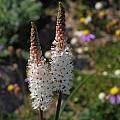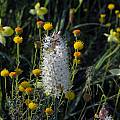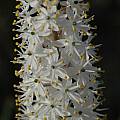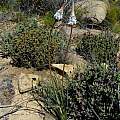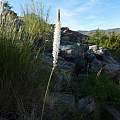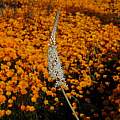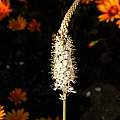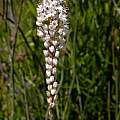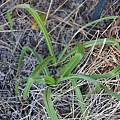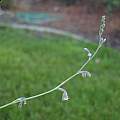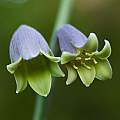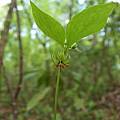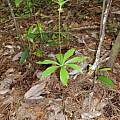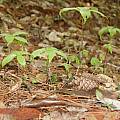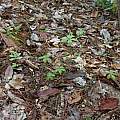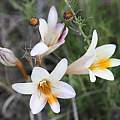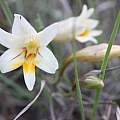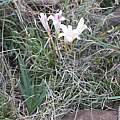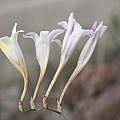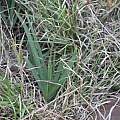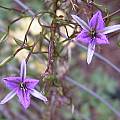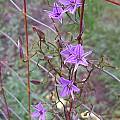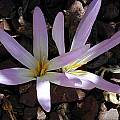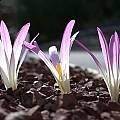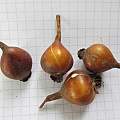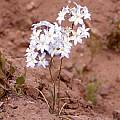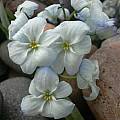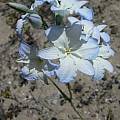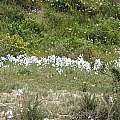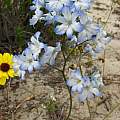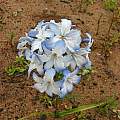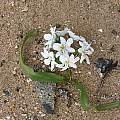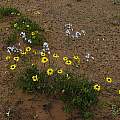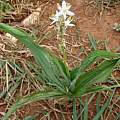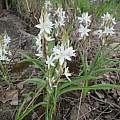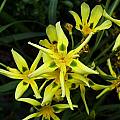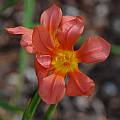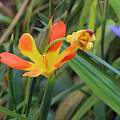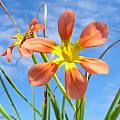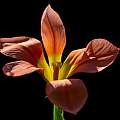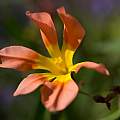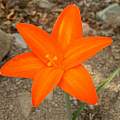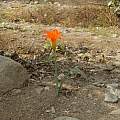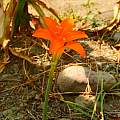This page is a random selection of wiki entries which is updated daily.You can subscribe to it as an RSS feed  The RSS feed contains 'media' data and can be used as a 'photo feed' by programs such as screen savers, slide shows and picture frames.Click to add Bulb Day to your MyYahoo page
The RSS feed contains 'media' data and can be used as a 'photo feed' by programs such as screen savers, slide shows and picture frames.Click to add Bulb Day to your MyYahoo page 
From Bulbinella on Friday 26th of April 2024 05:15:40 PM PDT
Bulbinella cauda-felis (L.f.) T.Durand & Schinz is widespread in the winter rainfall area of South Africa, growing on sandstone, granite, or clay. It flowers from August to December in the wild. White flowers with pink buds grow in a conical raceme. The 5 to 11 erect leaves are linear. The first two pictures were taken near Middelpos in the Roggeveld September 2006. The next two were taken near the Biedouw Valley in September 2006 where they were growing with the yellow form of Cyanella alba. Photos from Bob Rutemoeller and Mary Sue Ittner.
The first photo was taken in the Komsberg and the second near Kamieskroon in Namaqualand by Cameron McMaster. Photos three and four were taken in Namaqualand by Mary Sue Ittner. The last photo from the book Plants of the Klein Karoo courtesy of Jan and Anne Lise Schutte-Vlok.
From Prochnyanthes on Thursday 25th of April 2024 05:07:07 PM PDT
Prochnyanthes mexicana now Agave bulliana (Baker) Thiede & Eggli (also Bravoa bulliana, Prochnyanthes bulliana, Polianthes mexicana, and Prochnyanthes viridescens), is the only species and is found on dry rocky slopes in pine-oak grassland or in shaded moist ravines at 1150 to 3100 m. altitude in the states of Durango, Aguascalientes, Jalisco, Nayarit, Michoacán, and Zacatecas of Mexico. The flowers appear from late June to early September on spicate inflorescences 1 to 2 m. tall with 4 to 22 flowering nodes with paired flowers that are white tinged with grey-green or dull green on the exterior and red, white, or creamy on the interior.
The photos below show what appears to be a particularly dull-colored form of P. mexicana. Michael Mace remembers that he obtained seed of this bulb from Southwest Native Seed at least 10 years ago, when the company still offered seeds of Mexican bulbs. Unfortunately, the tag was lost, so he can't be sure of the identification. It's a summer-growing bulb that lives in San Jose, CA, in a mostly-shaded area at the base of a Japanese maple, where it gets some water but does not get soaked. Every August it produces a 6-foot (2 m) stalk of green flowers (with a purplish-gray bloom on the exterior).
From Medeola on Wednesday 24th of April 2024 05:26:55 PM PDT
Medeola virginiana is a monotypic species that occurs in eastern North America. These plants are from the southern extent of this species range in Gadsden County, Florida. Photos by Alani Davis.
From Freesia on Tuesday 23rd of April 2024 05:00:46 PM PDT
Freesia andersoniae L.Bolus is the only gullet-flowered species that occurs out of the winter rainfall area of South Africa. It is scattered across the central interior of South Africa and is typically restricted to the lower southern slopes of the dolerite and dolomite outcrops, wedged among rocks where there is protection from predators and cooler root temperatures and more moisture. Corms sprout with summer or fall rainfall, but flowering does not occur until spring, August to October but sometimes as early as May. This species is reported to be frost hardy. Growing 10 to 25 cm high, this species has 10 to 14 inclined to suberect leaves and 2 to 5 flowers in a spike. Flowers are 5 to 6 cm long, white to cream colored with the base of the lowermost tepal and inner edges of lower lateral tepals flushed orange. All three lower tepals have a dark brownish midline with purple chevrons in the tepal sinuses. Flowers are strongly lily scented, even at night which suggests they may be moth pollinated. It is similar to Freesia speciosa but has longer and narrower, acute leaves and internally marked purple lines. Photos from iNaturalist taken by lorainevdb in September near Cradock in the Eastern Cape and shared under a CC BY-NC license.
From Thysanotus on Monday 22nd of April 2024 05:59:12 PM PDT
Thysanotus patersonii has tuberous roots and is native to Western Australia and Victoria. It is found in the wild growing through shrubs and has short-lived violet flowers with fringed inner segments borne on lateral stems. It is considered a short lived plant and this was true for me. I kept it alive for several years and it bloomed two of those seasons including spring 2004. It seems to be gone now. Photos by Mary Sue Ittner of my plant climbing and flowering on a wire fence.
-
From Colchicum Species Two on Sunday 21st of April 2024 05:04:31 PM PDT
Colchicum montanum L. (syn. Merendera montana (L.) Lange, Merendera bulbocodioides Willd., Bulbocodium montanum (L.) Heynh.) has early fall blooming flowers which rest on the ground followed by linear leaves. It is found in meadows and rocky slopes in Spain and Portugal. The first two photos by John Lonsdale. The last photo of corms by Dr. Dimitri Zubov
From Zephyra on Saturday 20th of April 2024 05:09:01 PM PDT
Zephyra elegans, tentative ID confirmed by Harold Koopowitz and Alberto Castillo. The first photograph was taken by Jane McGary in October 2002 in an area of north coastal Chile just south of Antofogasta. She notes this coastal species probably will not tolerate much if any frost. The last two photos were taken by Osmani Baullosa.
In late September and early October, 2011, Eugene Zielinski and friends made a trip to Chile to observe (and photograph) the flowering desert. Exceptional midwinter rains, and even some snow, practically guaranteed heavy blooming from the bulbs, annuals, perennials, and shrubs in the desert. This species bloomed abundantly along the coast, particularly in the Huasco area. Flower color ranged from pure white to white with sky blue petal tips. These photographs were taken between Huasco and Carrizalillo by Eugene Zielinski. In the last photo it is pictured with Encelia canescens.
From Chlorophytum on Friday 19th of April 2024 05:04:50 PM PDT
Chlorophytum rubribracteatum (De Wild.) Kativu is native from Central through East and Southern Africa. Plants are grass-like, up to 45 cm tall growing from a short horizontal rhizome. Roots are slender with swellings towards the tips. The leaves are linear, in 2 rows, up to 50 cm with slightly ciliate margins. The inflorescence is unbranched with individual flowers sparsely arranged. Flowers are white to pinkish-white and seed capsules shallowly deltoid, approximately 7 mm long. Photos by Nicholas Wightman taken in Lilayi, Zambia.
From Homeria on Thursday 18th of April 2024 05:57:07 PM PDT
Moraea comptonii (L.Bolus) Goldblatt (syn. Homeria comptonii Goldblatt) is found in the Southwest Cape on clay slopes in renosterveld. It flowers in spring. It has a single linear trailing leaf and yellow or salmon flowers with a yellow center. Tepals often have a large central green mark and are coconut scented. This species is very close to Moraea elegans. The main difference is in the shape of the tepals. The tepals of Moraea comptonii are widest in the upper third and in M. elegans widest in the lower third. The anthers are longer than the style branches in Moraea elegans. The first photo was taken at Wave Hill where it was identified as this species although it could be Moraea elegans. Photo by Arnold Trachtenberg. The second photo by Mary Sue Ittner was taken of orange flowered plants grown from seed blooming March 2006 in between rainstorms. The next two photos were taken by. Alan Horstmann. The last two photos by Shlomit Heymann are of pots blooming in March on her balcony.
From Pyrolirion on Wednesday 17th of April 2024 05:35:24 PM PDT
Pyrolirion tubiflorum (L'Hér.) M.Roem. was named by L'Heritier in 1789. This species can be found in Peru, Ecuador and Bolivia, always next to crops and in between inter - Andean valleys ranging from 300 m to 3000 m. The perianth of Pyrolirion tubiflorum is up to 8 cm across in the upper part, the perianth tube is 1.8 cm wide, mostly green and it has a mild scent. Photos by Norton Cuba Melly.

